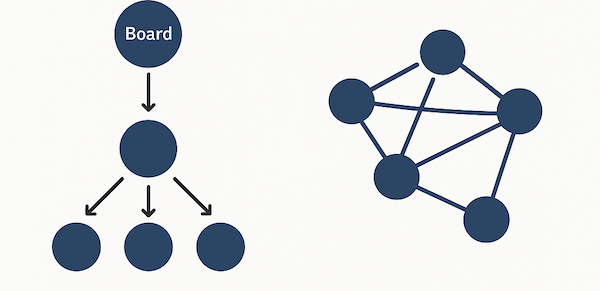Hierarchy is good.
It helps executives see the whole picture. Top management gets information from their management systems, analyzes it, and makes strategic decisions. Even better, thanks to strong authority and clear reporting lines, those decisions can be executed quickly.
So far, so good. 🙂
But, as customer needs and market dynamics change faster and faster, the management system needs more, faster, and more accurate data to keep up. Unfortunately, that means people throughout the organization spend more and more time collecting, processing, and feeding the mgt system so the board can decide.
So what? Well, all that effort draws attention away from customers and outcomes. It’s non-value work(no customer would ever pay for it.) Worse, the feedback loop between customer and board might becomes longer and longer. By the time information travels up and decisions come down, the context has already changed.
The Agile View: Connectivity
In Agile organizations, decisions are made closer to the customer, lower in the org. Feedback loops are shorter, so adaptation should happens faster.
But how can the teams make right decisions without having this total overview? Worse, top management also may loose some of that “total overview.”
That’s one reason why Agile orgs prefer connectivity. Connected people, systems, data, and teams instead of rigid reporting rules. Overlapping roles and shared visibility, not long reporting chains.
Still, connecting everything to everything isn’t the goal either. Org resilience requires loose coupling between product groups. Product group adaptability required tight coupling within them.
- Inside a product group → everything is connected to enable fast local decisions.
- Between product groups → looser connections preserve strategic adaptability.
This balance lets organizations move fast locally while staying coherent globally.

CAO Takeaway #1 – Shift from Reporting to Connecting
Hierarchies optimize for control and information flow upward. Agile organizations optimize for connectivity and learning across. The goal isn’t “no hierarchy,” but a different logic of coordination: shared visibility, overlapping roles, and rapid feedback loops instead of reporting chains.
CAO Takeaway #2 – Design for Loose and Tight Coupling
Adaptability depends on how units are coupled. CAO distinguishes two essential patterns:
- Tight coupling inside product groups → enables fast, integrated decisions.
- Loose coupling between product groups → maintains strategic flexibility.
Structure isn’t just boxes on an org chart. It is a design choice that shapes learning and speed.
CAO Takeaway #3 – Empower Capabilities, Not Just Insight
AI can enhance both top-level awareness and local decision quality. The CAO perspective: The challenge isn’t “who sees the most,” but who can act fastest and learn soonest.
Want To Explore More of the CAO approach?
Check out creatingagileorganizations.com for more details.
